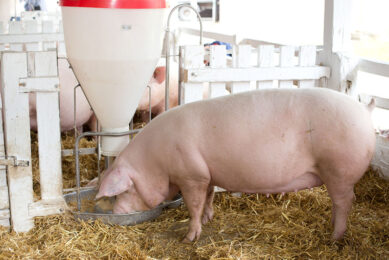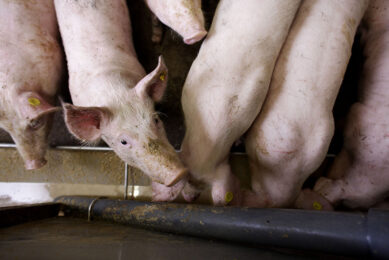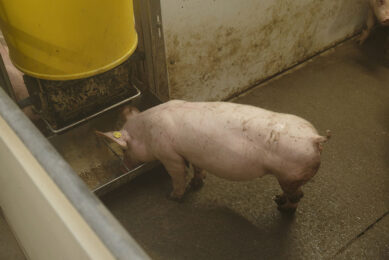Lowering crude protein levels in pig and poultry feed

Lowering crude protein levels in pig and poultry feeds can lead to considerable environmental advantages. Novel in-depth insights were shared about how to make sure pig performance is not at risk while doing so at a gathering by Metex Animal Nutrition, on November 9 in Breda, the Netherlands.
The event drew over 70 animal nutrition experts from the Netherlands and Belgium. In both countries, concerns have grown in recent years about the environmental impact of pig and poultry production. Nitrogen emissions are being discussed at high political levels, as many consider them to be too high. This leads governments to introduce legislation to bring down levels of ammonia emissions. In both countries, this means that reducing the amount of pig and poultry farms is on the table.
In other words – any technology that helps reducing nitrogen levels in pig and poultry manure could be a tool in getting emissions under control.
Lowering crude protein levels
The meeting was kicked off by Théophane de Rauglaudre of Laval University in Québec, Canada. His focus was on low protein diets. He shared the results of various studies as to what would be the effect of lowering crude protein levels in both broilers as well as pigs, predominantly on nitrogen emissions. When lowering crude protein with 10 g/kg, nitrogen losses come down to 18% in broilers and 10% in pigs, he said. In both animal groups, there was an effect on NH3, but no effect on N2O, he said. In his conclusion, he wrote that crude protein reduction can be achieved, if all essential amino acids are controlled. This would have “no effect on growth and body composition.”
Carbon footprint of pigs and poultry
The next speaker was William Lambert of Metex Animal Nutrition. He spoke about the influence of amino acid strategies on the carbon footprint of pigs and poultry. He started out by mentioning that feed is the main contributor to carbon footprint of animal production. A key message in his presentation was that sourcing of materials does play a role – and that in terms of carbon footprint sourcing amino acids locally makes more sense than sourcing those from China. He advised to use recognised and official databases to make sure that any Life Cycle Assessment will be accepted.
Life cycle assessment of feed
Consultancy firm Blonk Sustainability in the Netherlands was asked to make a life cycle assessment of feeds that are low in protein levels, with examples from both England and Germany. On behalf of Blonk, Nicolò Braconi introduced the effects of animal production on climate change (with and without land use change) as well as acidification. He concluded that low-protein feed strategies with support of “free amino acids” can have environmental advantages due to a change in land use; emission levels of ammonia being lower and lower phosphorus emissions as well as eutrophication of fresh water.
Piglet feed survey in Europe
On behalf of Metex Animal Nutrition, Aude Simongiovanni presented the results of a Europe-wide piglet feed survey, with over 200 feed samples being analysed. Starter and pre-starter feeds were analysed in countries throughout Europe, between November 2022 and February 2023. Particular attention was paid to the “market context,” as the aim is to lower crude protein levels. This would have to result in controlling dietary lysine and other amino acid levels to avoid performance degradation or behaviour issues. As the event was held for a mixed Belgian-Dutch audience, she highlighted the results from these 2 countries. She emphasised that both countries scored average results both in starter and pre-starter feeds.
Reducing crude protein levels and pig behaviour
Dr Alfons Jansman of Wageningen University & Research gave the next presentation. He presented the first outcomes of a wider research, carried out with researcher Ilaria Minussi, to the effects of reducing crude protein levels to pig behaviour. He took the angle of tail biting, as stopping with tail docking is also a trend in the European Union. A recent trial had been set up to compare 4 different kinds of feeding regimes:
Control;
Reduced crude protein levels (-20%); through lower standardised ileal digestible (SID) lysine levels, and uncontrolled protein profile;
Reduced crude protein levels (-20%) with a maintained level of SID lysine with a protein profile balanced with essential amino acids;
- Reduced crude protein levels (-20%) through lower SID lysine levels, and uncontrolled protein profile with enrichment.
Among the results, the team found that a low crude protein diet decreases performance. However, they also observed that it led to an increase in activity, i.e. tail biting. Providing extra enrichment to an amino acid deficient diet slightly loses efficacy counteracting tail biting with time, he added. Amino acid supplementation to the animals’ requirements for growth, however, largely mitigated the negative effects of low crude protein diets on tail biting.
Finally, the diets with lower crude protein levels via constant SID lysine and amino acid supplementation didn’t show any decrease of performance, largely mitigated the negative effects of low and unbalanced protein profile on aggressive behaviour.
Supplementing leucine to weaner pigs
The next speaker was Dr Sam Millet of the Belgian Institute for Agricultural, Fisheries and Food Research. He talked about a recent study in which they investigated whether supplementation with leucine would improve homogeneity in weaned piglets. Leucine supplementation improves protein synthesis in the muscles and thus promotes growth. The hypothesis of the study was that the leucine requirement of light piglets is higher than that of heavy piglets. And although the scientists found that there was an interaction between weight category (light vs heavy) and leucine dose, it was not shown that smaller piglets need more leucine. It is recommended to stick to the 100% minimum standard for the standardised ileal digestible (SID) Leu:Lys.
Introducing bio-sourced butyrate for piglets
The last speaker of the day was Vincent Couture of Metex Animal Nutrition. He presented research results that emphasise the positive effects of a newly available bio-sourced butyrate on feed intake and growth of post-weaning piglets. This new source of butyrate is produced by fermentation and the production process is fully circular, said Couture. To prove the effect of this new product, 2 trails were conducted at Ghent University, Belgium. In addition, a literature review was carried out. The studies showed that supplementation of piglets with the additive improved the performance, due to an increase in feed intake and feed conversion. In addition it was shown that supplementation reduced the incidence of diarrhoea during the pre-starter period. In addition, a literature review was carried out in order to defined the standard of performance of butyrate product. It appears that the results of the two trials in Ghent exceeded the literature expectations.
The Pig Progress Newsletter
Sign up for our newsletter and receive all our need-to-know content three times a week.











